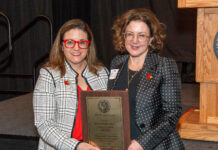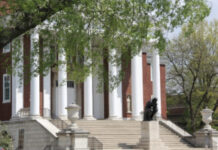The exhibit has as its core 38 works from the Brooklyn Museum in New York, one of the first museums to collect Impressionist work. That group of paintings has been exhibited as a whole in a few locations outside of Brooklyn, said associate curator Kim Spence, but the Speed has expanded the exhibit with 35 works from its own and other collections in Kentucky.
The result, said curator Ruth Cloudman, is “a very beautiful and very unique exhibition.”
“Since these works will never again be shown together, this is literally a once-in-a-lifetime opportunity to see an extraordinary range of Impressionist paintings,” she said.
“Impressionist Landscapes” primarily includes works by French Impressionists and those from the United States, including the Kentuckian Paul Sawyier.
The earliest work in the exhibit pre-dates the Impressionist period by more than a decade. The latest work, dated in the 1920s, the decade of Monet’s death, post-dates the period.
By including artists who influenced the Impressionists and those who followed and were inspired by the Impressionists, the exhibit, Spence said, gives the full picture of the significance of Impressionism.
“Impressionist Landscapes” includes works from the Barbizon School of French painting of the 1850s and 1860s, when such artists as Charles François Daubigny first took their canvases out of their studios to capture nature; American Impressionists, the most unified offshoot of the French school, who often studied and painted in France before returning to paint U.S. landscape; and post-Impressionists who took the use of color to a new level.
Impressionist painters, themselves, broke with tradition by painting landscapes not as part of a story or mythological tale, but for their own intrinsic beauty. They left their studios and took their canvasses outside, thereby capturing light and color in a new, more realistic way. Their works appealed especially to people who lived in the bustling Industrial Age cities.
Monet and others often painted the middle class at leisure — on the beach, in the countryside, playing games, Cloudman told a group previewing the exhibit on Feb. 2. One of John Singer Sargent’s titles, she continued, sums it up nicely. Translated, it means, “The Sweetness of Doing Nothing.”
“Impressionism is thought of as gorgeous, high-class, eye candy,” but in last 25 years, scholars have found that some Impressionist paintings also speak about change in the modern world, Cloudman said. Charles-Francois Daubigny’s “The River Seine at Montes” shows smokestacks beside church spires. Alfred Sisley captured trains and telegraph poles in “Hilly Path.”
Besides Impressionist paintings, the exhibit area includes “The Gardens of Giverny: A View of Monet’s World; photographs by Stephen Shore,” taken in 1974. “Light into Line,” an complementary exhibit of Impressionist prints, will open Feb. 9. It will run through June 5. “Impressionist Landscapes” will run through May 22.


























